Autun to Cussy-en-Morvan
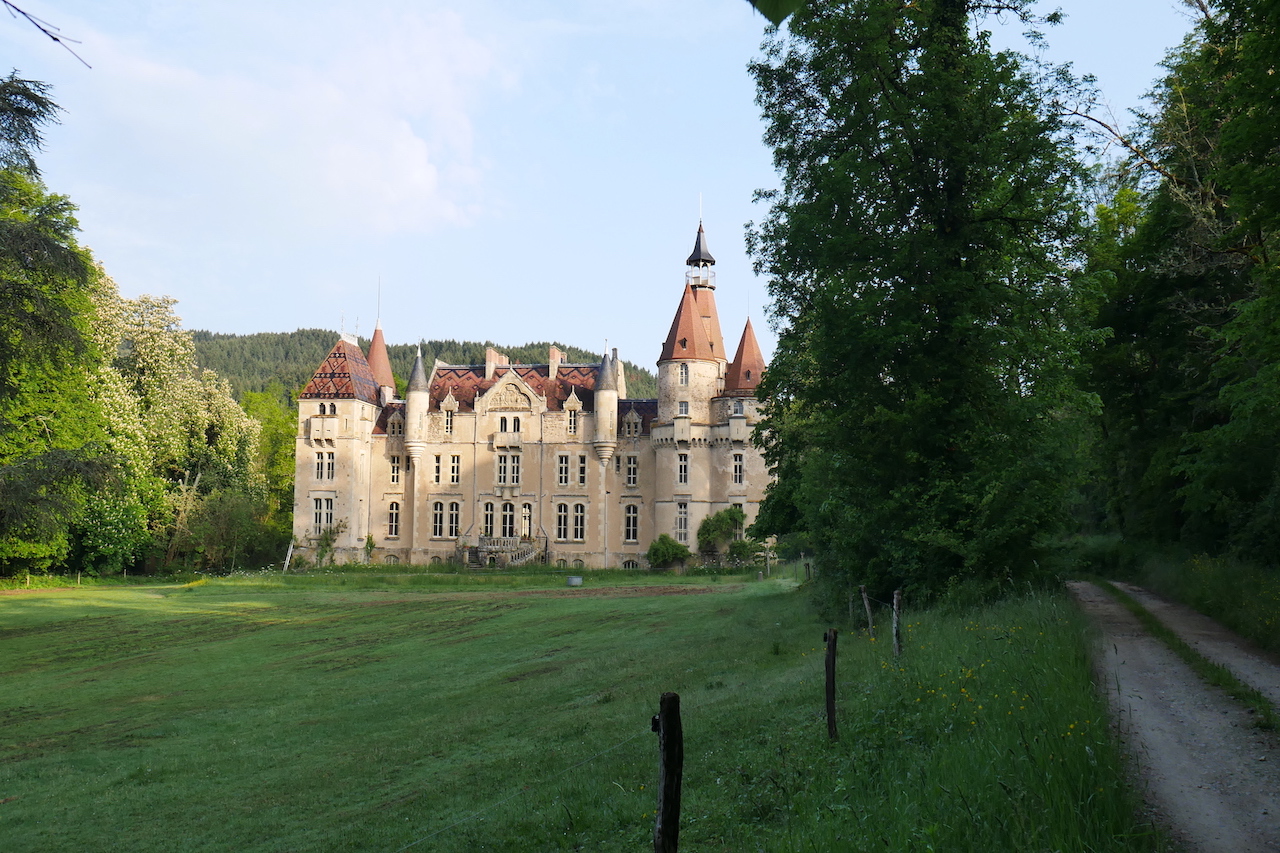
Bourgogne-Franche-Comté
13. Autun to Cussy-en-Morvan
Medium
5h
23,4km
+503m
-372m
Step
Embed this item to access it offline
During this day you leave the plains with the bush hedges around Autun to enter the Morvan Natural Park which has a varied ecosystem, mixing forests, hedgerows and rivers in a hilly relief that offers landscapes with colors appreciated in every season. You will have an appointment with a charming castle surrounded by forests.
12 points of interest
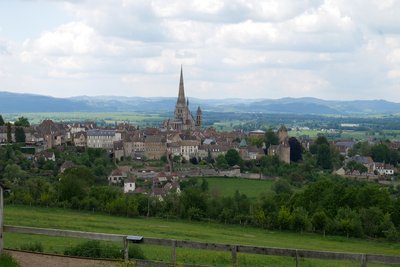
L’imposante cathédrale domine la ville d’Autun - Amis saint Colomban TouristSaint Lazarus Cathedral in Autun
A first cathedral was built in Autun from the 5th century, later consecrated to Saint-Nazaire (a 14th century chapel remains). The church of Saint-Lazare (dedicated to the saint Lazare of the Gospel) was planned by the bishop of Autun, Étienne Ier de Baugé, in order to preserve the relics which were believed to be those of this saint, but which were in fact those of Saint Lazare of Aix. These relics were kept until then in Marseilles.
The construction of the building began around 1120 by Etienne de Baugé, it was completed in 1146, and the porch a few years later. It is built on the model of the abbey church of Paray-le-Monial. The church has, as in Cluny and Paray, a broken barrel vault, built shortly after its consecration as a cathedral, since buttresses were added at that time. A spire was built in 1469 by Cardinal Rolin (the son of Chancellor Rolin), above the transept crossing, in place of a Romanesque bell tower destroyed by lightning. It is 80 m high. In 1476, Cardinal Jean Rolin donated the Marthe bell, the cathedral's bumblebee, which weighs 3,360 kg and has a diameter of 1.69 square metres. It still rings alongside three other bells dating from 1854.
The portal is the most remarkable element of the cathedral. It was made to represent the Last Judgement, by Gislebert, who signs his name at the feet of Christ.
For several years now the cathedral has been undergoing restoration work which will restore the building to its full majesty in the image of the tympanum restored in 2009.
More information: Wikipedia
Les remparts gallo-romains d’Autun - Amis saint Colomban HistoricalThe best preserved Gallo-Roman ramparts in all of Gaul.
The enclosure is about 6 kilometres long and is one of the best preserved in all of Gaul since more than two thirds of its layout still exists. The walls have a homogeneous thickness of about 2.50 metres, which has enabled them to act as retaining walls. A 2007 study showed the existence of 48 sections of curtain wall (roughly the walls) and a further 30 towers, of which the original number is estimated at 57, the regularity of the layout and construction allowing this estimate to be made. The walls are thought to have been completed during the Tiberian period. For the southern tip of the enclosure at the level of the Ursuline tower, seems to be a later extension, probably from the 3rd century, but without certainty.
Portes des Bancs, Autun - Amis saint Colomban HistoricalLa Porte des Bancs, Autun
The only opening of the upper town to the north, the gate of the benches owes its name to the stalls of butchers who were obliged to cut meat in the Middle Ages in a neighbouring room.
Its primitive state in the 5th century is poorly known. From the 12th-century door there remains on the left the groove where the closing harrow used to slide, as well as two walled doors. In 1360 a new gate flanked by two towers was built in front of the previous one, the left tower and the drawbridge apron remain.
Information panel on the site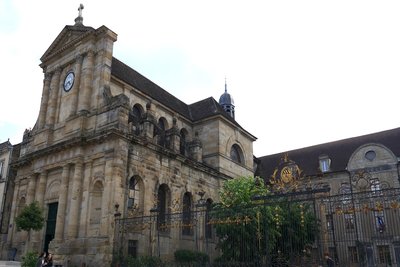
L’église Notre-Dame et le lycée Bonaparte attenant - Amis saint Colomban HistoricalAutun, imperial city
Joseph and Napoleon Bonaparte arrived in Autun on the 1st January 1779, led by their father who was going to Versailles as deputy of the nobility of Corsica (reunited with France in 1768); the bishop of Autun was then Alexandre de Marbeuf, nephew of General de Marbeuf, in charge of the administration of Corsica and the command of the troops, which probably explains the choice of Autun for the Bonaparte brothers. Napoleon having been admitted to the military school of Brienne left the college of Autun on the 20th or 21st April 1779. Joseph remained there until the end of August 1783. His teachers, who kept the memory of a proud and imperious Napoleon, involved in fights, described Joseph as a gentle and quiet, serious and diligent. Three years in a row he received "testimonials of satisfaction" at the prize-giving ceremony. His younger brother Lucien joined him at the end of 1782, and was a pupil of the college for twenty (or twenty-two) months.
It should be noted that there is a military college in Autun near the Roman theatre.
Théâtre romain d’Autun - Amis saint Colomban HistoricalThe Autun Roman Theatre
The eastern part of the city was an entertainment district. This is where the theatre and the amphitheatre are located. The amphitheatre was finally dismantled in the second half of the 17th century. Its diameter was equivalent to that of the theatre and, according to the excavations, it can be said that it was located between the Avenue du 2e Dragon and the Rue du Théâtre Romain, below the Marble Promenade. Unfortunately, nothing remains of it.
As far as the Roman theatre is concerned, that's a different matter altogether. Indeed it is one of the most obvious vestiges of the ancient period in Autun. It is one of the visible signs of the power and prosperity of the city of Augustodunum (Autun) in the Roman Empire. With its 148 metres in diameter and 20,000 seats, it is, to the best of our knowledge, the largest Roman theatre still standing in the western part of the Empire; the only one to surpass it was Pompey's theatre in Rome, and its dimensions and number of seats were probably equivalent (estimated at 150 metres in diameter for a little over 20,000 seats).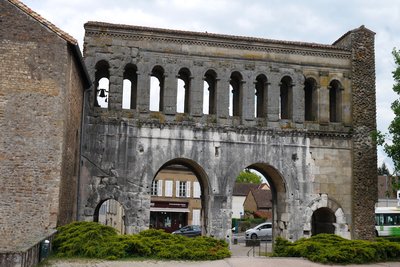
Porte Saint-André - Amis saint Colomban HistoricalSaint Andrew's Gate, Autun
Colomban and his companions made a stop in Autun, probably passing under this Gate.
The Saint Andrew's Gate is part of the Roman city walls. It is located at the eastern exit of the city, on the former Decumanus Maximus and the road leading to Besançon and Dijon.
The gate includes, in the lower part, two central bays allowing the circulation of vehicles framed by two pedestrian crossings. This ensemble is surmounted by a gallery composed of ten arcades flanked by fluted pilasters. The gallery is crowned by a cornice entablature. The gate was protected by two semicircular towers. The one on the right has been transformed. It now houses the Protestant temple of Autun. Only a fragment of the wall of the tower on the left remains.
The gallery is a reconstruction dating from Late Antiquity. The vaults on the ground floor have been restored. The vaults of the gallery were "invented" by Viollet-le-Duc in the 19th century.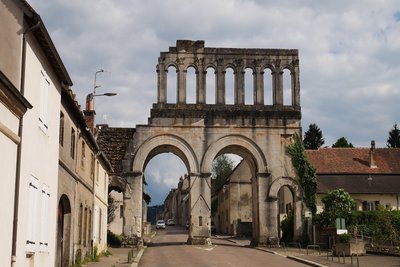
Porte d'Arroux - Amis saint Colomban HistoricalAutun Arroux Door
Leaving Autun Colomban and his companions probably passed through this door. From the cathedral of Autun on your way to Cussy-en-Morvan you will pass under the Porte d'Arroux, part of the Roman ramparts of the city. It is located at the eastern exit of the city, on the old Cardo Maximus and the northern exit of the via Agrippa going towards Saulieu and Auxerre and the road to Bourges.
The gate includes, in the lower part, two central bays allowing the circulation of vehicles framed by two pedestrian crossings. This ensemble is surmounted by a gallery that was composed of ten arcades (7 remain today) flanked by fluted pilasters. The gallery is crowned by a cornice entablature. The gate was protected by two semicircular towers that have disappeared.
The upper gallery of the gate inspired the architects who built buildings for the Cluny order.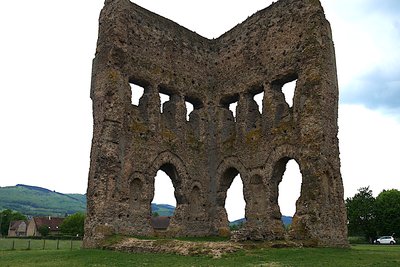
Temple dit de Janus - Amis saint Colomban HistoricalThe Temple of Janus, Autun
Away from the Via Columbani you will see it when you start your stage towards Cussy-en-Morvan.
Nowadays, only the cella of the so-called temple of Janus is preserved; it is the place where the statue of the god was located and where only priests entered. The cella certainly dates from the 1st century AD, a date deduced from the architectural technique used called "small device". It is 24 meters high and was certainly closed above by a roof that suggests an even greater size. The building was roughly square in shape, the walls measuring about 16 to 17 metres each. The entrance was probably on one of the missing walls, which seems to indicate that the temple was oriented from east to west. The sanctuary wall certainly followed the contour of the plot between the road and the surrounding meadows.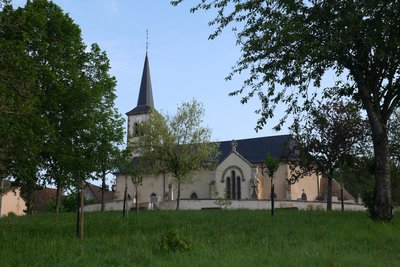
L’église Saint-Martial de Sommant - Amis saint Colomban TouristSaint-Martial Church in Sommant
In the village, the church of Sommant, dedicated to Saint Martial, was built in the 11th century by the abbey of Saint-Martin d'Autun, and enlarged in the 19th century. According to Baudiau, the choir was hexagonal in shape, preceded by two "unsightly and stylish" pillars supporting a small shingled bell tower. In 1856 the nave was enlarged: the bell tower, a tower with twin bays, supported inside by three ogival arches, was moved to the west portal. Its "high square spire dominated all the surroundings". Unfortunately, in 1861 a hurricane overturned the bell tower on the nave, which collapsed. The church had to be rebuilt (1862). Today the church has a cross plan and a small sacristy. It is still partly surrounded by the cemetery. The chapels are covered with glazed and coloured tiles, while the nave and the bell tower are covered with slates. Recently restored, it has kept its cachet.
Château de Valogne à Sommant - Amis saint Colomban HistoricalValogne Castle in Sommant
The impressive castle of Valogne (Vallis longa, the long valley), is located north-west of the town of Sommant, on the left bank of the river Taronam, Tarnin or Ternin. Hidden in the greenery, behind abundant foliage, it is barely visible on your left from the Via Columbani.
The fiefdom of Sommant was held by various lords. Jean de Châtillon-en-Bazois, a knight, made a tribute in 1260 to Abbot Guillaume of all that he owned in Sommant as well as in La Celle. Hugues de Sommant fulfilled the same duty in 1370.
Anne-Paul de Fontenay, squire, adviser to the king, lieutenant-general of the bailiwicks of Montcenis, Semur-en-Brionnais and Autun, was lord of Sommant in 1766. He was elected deputy of the nobility to the États-Généraux in 1789 and became the first president of the presidential seat (mayor) of Autun.
Claude Chermain (CLP)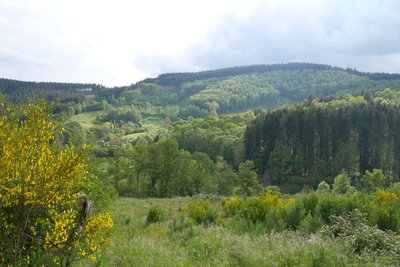
Paysage du Morvan - Amis saint Colomban PanoramicThe Morvan Natural Park
The Morvan Regional Nature Park is a French regional nature park located in the Morvan massif, in the heart of the Burgundy-Franche-Comté region. Created in 1970, it brings together 117 member communes and 5 gateway towns since the last revision of its charter in 2007 and the renewal of its approval in 2008.
The Morvan has a rich ecosystem, combining forests, hedgerows and rivers. However, the biosphere is not safe from threats such as water pollution, the uprooting of hedges (which constitute a refuge for many species) or the reduction of deciduous forests.
Le Bourg de Cussy-en-Morvan - Amis saint Colomban TouristChurch of Saint Peter and Saint Paul in Cussy-en-Morvan
Dedicated in the past to Saint-Léger (today Saint-Pierre and Saint-Paul), the time of its construction is not known but it is mentioned as early as the 10th century: the bell tower of Cussy was one of the five bell towers making up the Marquisate of Roussillon, it was the highest of all the surrounding parishes. The choir and the two side chapels are said to date from the 15th century; the nave, flanked by two side aisles, was rebuilt in 1851; the two bells were rebuilt in 1858 by Auguste Hildebrand, founder of his majesty the Emperor. Seven statues from the 15th to 17th centuries, classified or inscribed as historical monuments, and two liturgical pools from the 16th century, also historical monuments, can be admired.
Description
Place de Terreau, go down rue des Bancs, right and left, Petite rue Chauchien, left Grande rue Chauchien, right rue des Cordeliers, right rue de l'Arbalète, left rue de l'Arquebuse, follow the Promenade des Marbres, rue de la Croix Verte, cross the roundabout, rue des Fusiliers Marins, left rue de Gaillons, Porte Saint-André, left rue de la Croix Blanche, opposite rue de Dijon, right rue de Paris, rue du faubourg d'Arroux, Porte d'Arroux, cross the Arroux,
- Route de Saulieu, after the last houses on the left, rue du Puit d'Alligny, Grande rue de Chambois, crossroads with the cross on the right
- Before the Château Morcoux, take a dirt track on the left, then turn right, straight ahead at La Chaume, D 278 at the Moulin de Sommant.
- Cross the crossroads of Sommant, rue de la Mairie
- At the crossroads on the dirt road in front of you
- After 2800 meters turn left towards Allye, cross Allye and continue on a dirt road, col de la Croix d'Allye.
- Turn left on the asphalt road, Le Crapissot cross the D 88.
- Straight down the dirt road towards Cussy-en-Morvan along the cemetery, straight on rue du Lavoir, first on the right you have arrived in front of the church of Cussy-en-Morvan.
- Departure : Saint Lazarus Cathedral, place du Terreau, 71 400 Autun
- Arrival : Church of Saint Peter and Saint Paul, 4 rue de l'Europe, 71 550 Cussy-en-Morvan
- Towns crossed : Bourgogne-Franche-Comté
Altimetric profile
Report a problem or an error
If you have found an error on this page or if you have noticed any problems during your hike, please report them to us here:







